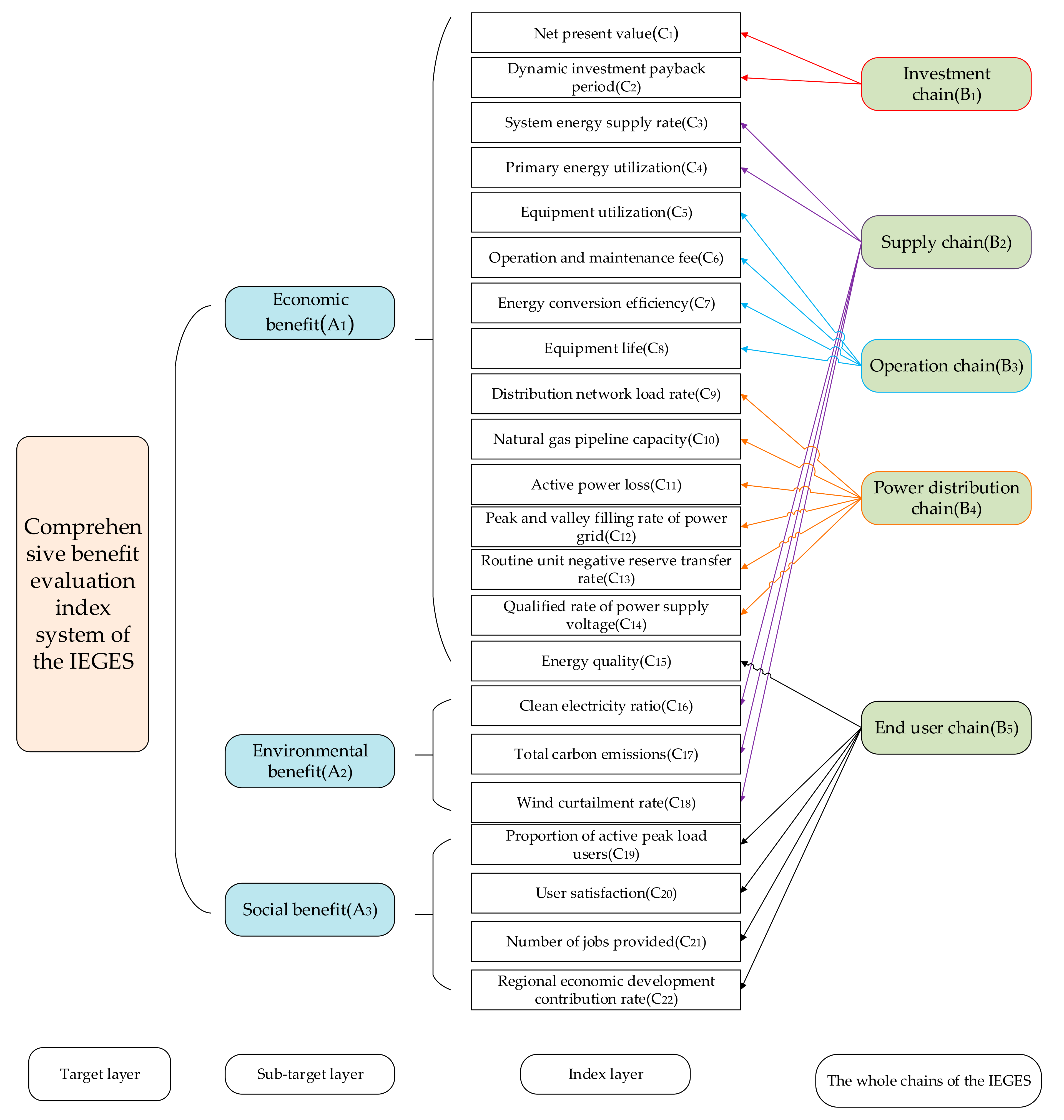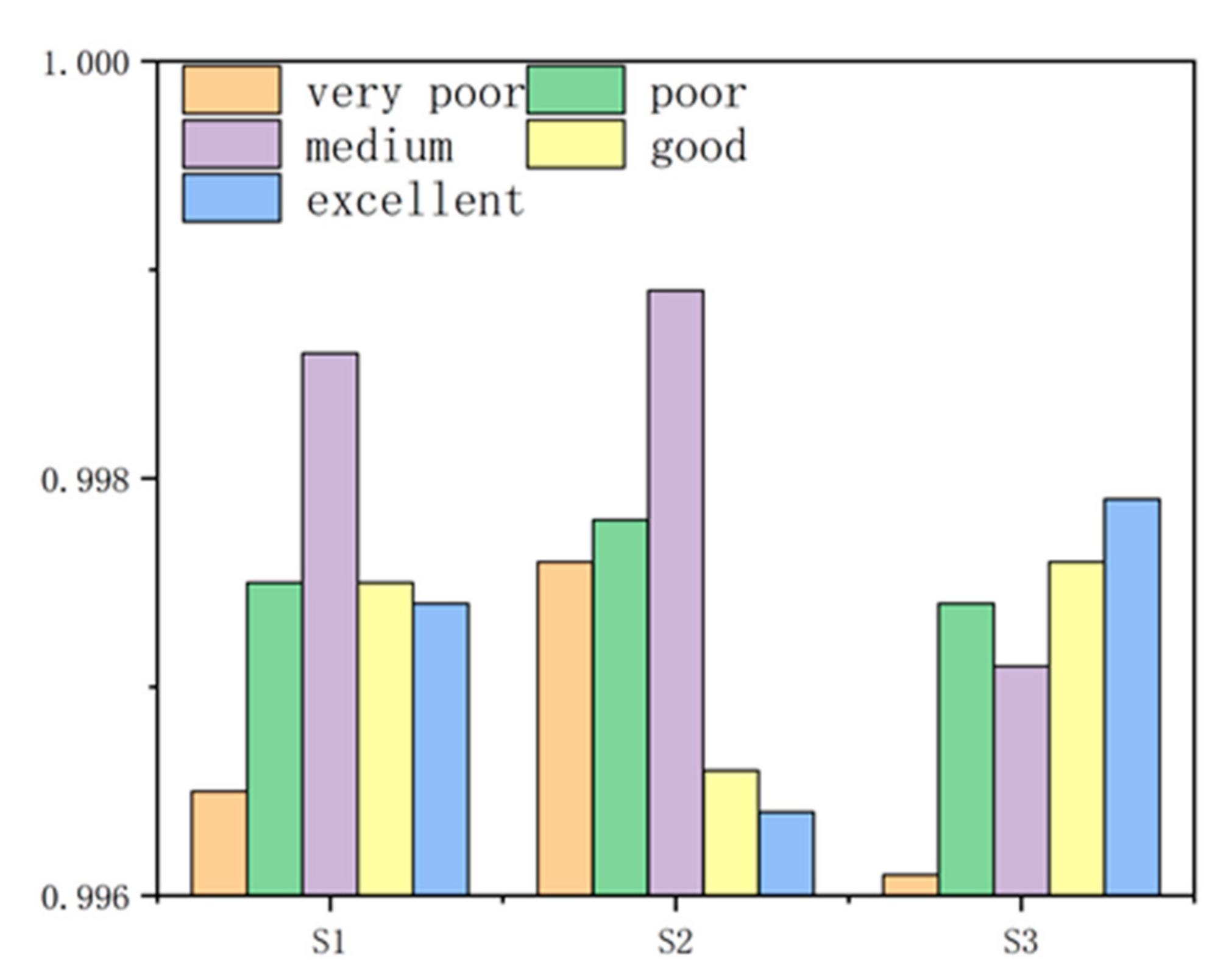In different energy center models, there will be a variety of different energy sources coupled to achieve flexible conversion in different systems. The conversion equipment of the integrated electricity–gas energy system (IEGES) includes power to gas (P2G), gas turbines and gas boilers, which can establish redundant connections between input and output ports.
In the IEGES, the power system and natural gas system rely on P2G equipment and gas turbines and other energy conversion equipment to couple in the energy center. The role of the gas-fired unit is to quickly convert natural gas into electricity, and make up for the difference in the power load curve [
1]. When the power generation output in the power system exceeds the power load demand, especially during the night, P2G equipment can convert electrical energy into artificial natural gas through electrolysis methanation reaction and inject natural gas storage in pipelines or tanks. In addition, in the power system, P2G equipment has a load point function to achieve peak shaving of participating units and reduces power system congestion [
2]. P2G equipment promotes the backup of the gas and electricity system, which greatly improves the flexibility and safety of the operation of the IEGES.
1.1. Literature Review
As an important physical carrier of the Energy Internet, the integrated energy system (IES) requires the conversion and coordination of multiple energy sources to achieve high-efficiency utilization during its utilization process [
3,
4]. At present, many scholars have studied power to gas, and power to heat from different angles. With the development of P2G technology, the multienergy system composed of electric power system and natural gas system has gradually developed and become an important part of IES [
5]. Jiang, Y.B. et al. [
6] studied the partial renewable power fluctuation on the power network, which is transferred to the gas system and cooling or heating system by the coordinated operation. N. Gholizadeh et al. [
7] analyzed the two technologies of P2G equipment: electric-to-hydrogen and electric-to-methane. The experimental results showed that the conversion efficiency of electric-to-hydrogen is higher than that of electric-to-methane, but electric-to-methane has higher economical value; Boreum Lee et al. [
8] verified that P2G technology provides new solutions for the consumption of renewable energy. Wang, J et al. [
9] proposed a cooperative and complementary operation scheme for distributed cooling, heating and power supply systems in multiple regions by analyzing the disadvantages of the distributed combined heat and power system. Jiang Z.X. et al. [
10] considered the IES of photovoltaic, wind, natural gas and power coupling and complementarity. Gao, Y. et al. [
11] studied the integrated modeling of power system, thermodynamic system and natural gas system coupling, and proposed the control strategy of collaborative optimization. Guan, T.T. et al. [
12] studied the partial renewable power fluctuation on power network, which was transferred to the gas system and cooling or heating system.
At present, many scholars pay attention to the comprehensive evaluation of IES, including security, reliability, economy and environmental friendliness. For example, from the perspective of system reliability, Juanwei, C et al. [
13] constructed some reliability indices of natural gas system while considering reliability of the power distribution system. Wang et al. [
14] applied some technical indicators including the failure rate, the repair rate, the availability and the mean time to failure to evaluate the reliability of the building cooling, heating and power system. From the perspective of economy performance, Nisan et al. [
15] conducted a sensitivity study on the cost of desalination under combined heat and power through different indicators including fossil fuel prices, interest rates and discount rates and electricity costs. Rozakis et al. [
16] evaluated a combined renewable energy system from the perspective of economic feasibility, agricultural income, impact on local development, renewable energy consumption, etc. El-Emam et al. [
17] proposed an integrated energy system driven by solar power, and conducted sensitivity analysis of several economic indicators to evaluate economic benefit. Meng et al. [
18] made the economic evaluation on levelized cost of electricity. Wan et al. [
19] presented a technoeconomic analysis to examine the feasibility of sago biomass-based combined heat and power system. From the perspective of environmental performance, Xu et al. [
20] set the CO
2 capture compression indicator to achieve effective evaluation of energy efficiency of coal-fired power plants. Dicorato et al. [
21] proposed a linear programming optimization procedure based on energy flow optimization model to evaluate the contribution of distributed-generation production and energy-efficiency. In the evaluation process, indicators such as operating costs and environmental pollutant emissions were mainly used. Kim et al. [
22] established an environmental indicator system for a photovoltaic responsive dimming system using LED lighting. Dai et al. [
23] applied annual energetic and economic performance indicator system to made evaluation of IES. Mancarella et al. [
24] used the air quality standard to evaluate the emission reduction capacity of distributed cogeneration system, and quantified the contribution to cogeneration system emissions. Müller et al. [
25] proposed a methodical approach for the multimodal energy system and conducted a technology impact evaluation. From the perspective of energy demand, Wang et al. [
26] analyzed the energetic, economic and environmental performances of disruption of the building cooling, heating and power system, and constructed a reliability and availability evaluation model. Möllersten et al. [
27] used the two criteria of potential CO
2 reduction and cost of CO
2 reduction to evaluate technical energy measures in Swedish. CO
2 capture and reliable CO
2 sequestration technologies were important potential contributors to Swedish compliance with Kyoto Protocol targets. Lv et al. [
28] constructed the reliability evaluation of the integrated energy system from the perspective of dynamic behavior of loads and operation strategy, and then proposed a novel reliability evaluation method with the comprehensive consideration of the dynamic behavior. However, the current research has not yet defined the comprehensive benefits of IEGES. In addition, scholars have not sorted out the entire operation of the IEGES, which has led to an incomplete comprehensive benefit evaluation indicator system. Therefore, the in-depth study on the standard comprehensive benefit evaluation indicator system of IEGES is very critical.
In addition, in recent years, more and more scholars have focused on the evaluation of other aspects of benefits or comprehensive performance of the integrated energy system. Ren et al. [
29] developed the mixed integer linear programming model for integration planning and evaluation for distributed energy resources (DER). The evaluation indicators including energy load, climate data, utility rate structure and DER technical information. Yong et al. [
30] constructed a wide range of technical, environmental and economic indicators to evaluate Malaysia photovoltaic systems. Abbasi et al. [
31] constructed energy and economic indicators of a combined cooling, heating and power (CCHP) system in Iran, and presented appropriate condition of its operation. Finally, the design scheme with the highest comprehensive evaluation benefit was selected. Cho et al. [
32] established optimization evaluation model for combined cooling, heating and power (CCHP) systems through operational cost, primary energy consumption (PEC), and carbon dioxide emissions (CDE). Yang et al. [
33] considered the aspects of technology, economy, environment and society to evaluated the planning schemes of distributed energy supply systems. Wang et al. [
34] applied heating capacity and energy consumption, heating seasonal performance to conduct a systematic assessment of CO
2 heat pump system integrated with thermal energy storage (TES) systems.
In terms of evaluation methods, most current scholars use simple sensitivity analysis methods to evaluate benefits based on their optimized models. Some scholars have put forward a universal comprehensive evaluation indicator system. Tan et al. [
35] put forward the universal steps of fuzzy evaluation measure in order to assess the mitigation responsibilities in China. Li et al. [
36] presented mixed integer and non-linear programming (MINLP) to assess a distributed combined heating, cooling and power generation system in Beijing. Hammond et al. [
37] applied a life-cycle assessment (LCA) to study the performance of a domestic building integrated photovoltaic (BIPV) system. Gejirifu et al. [
38] utilized the characteristics of the intuitionistic fuzzy set theory and proposed universal steps of a comprehensive evaluation indicator system. However, existing studies have considered only a single decision subject matter, and the significance of using bilevel programming theory is only in capturing key decision variables. However, the current comprehensive evaluation model are still relatively rough, and most of them use fuzzy evaluation methods, which easily lead to the same evaluation rank results, which cannot meet the accuracy required by scientific evaluation. Therefore, this paper uses MEE to optimize the TOPSIS model to overcome the current shortcomings.
The main content and structure of this paper are as follows:
Section 1 reviews and summarizes the research trends of the IEGES, and puts forward the literature research and innovation;
Section 2 constructs the comprehensive benefit evaluation indicator system of the IEGES based on its operation chains, and then analyzes economic, environmental and social benefits;
Section 3 builds the indicator weight calculation model based on the entropy weight method and order relation method;
Section 4 designs the specific calculation process of the technique for order preference by similarity to ideal solution (TOPSIS) optimized by the matter-element extension (MEE);
Section 5 conducts an empirical analysis and makes comparative results discussion and
Appendix A summarizes the research results of this paper.
1.2. Innovation
The main innovations include three aspects.
(1) Designing a standard comprehensive benefit indicator system for IEGES. This paper proposes all operational chains including planning investment, supply, operation, power distribution and terminal users to refine indicators. Then, constructing an indicator system of economic, environmental and social benefits of IEGES.
(2) Establishing a variable weighting model based on the order relation method and entropy weight method. Since the comprehensive evaluation indicator system for IEGES is still in the preliminary research stage, a comprehensive weight determination method combining objective and supervisor must be adopted. In addition, this paper uses the order relation method to solve the problem of inaccuracy caused by cross-meaning and mutual influence between indicators.
(3) Constructing IEGES comprehensive benefit evaluation model. The TOPSIS model can only sort the evaluation results. It can not directly reflect comprehensive benefit accuracy. Based on the proximity of each indicator to each grade interval, this paper applies the matter-element extension method to achieve refined evaluation of comprehensive benefits.









